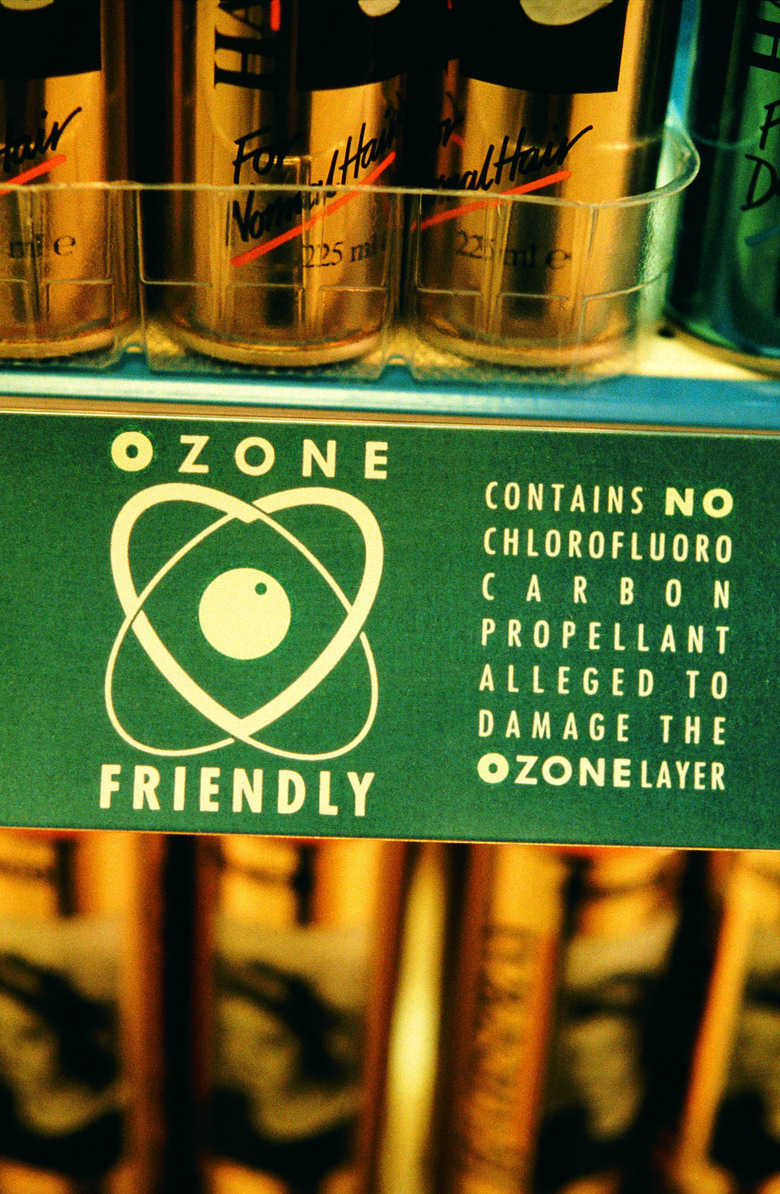What Is Harming The Ozone Layer?
The ozone layer is a section of the Earth's atmosphere filled with molecules that block harmful ultraviolet radiation from reaching the surface. In 1985, scientists from the British Antarctic Survey discovered that ozone concentrations over the South Pole were decreasing at an alarming rate, creating a hole in the protective layer. This led to a scientific search for the culprits, as well as a new understanding of the ways in which humans affect the environment.
CFCs and Ozone-Depleting Substances
CFCs and Ozone-Depleting Substances
Studies by the British Antarctic Survey and the U.S. National Oceanic and Atmospheric Administration concluded that chemicals used primarily in refrigeration and fire prevention were depleting the ozone layer. Chlorofluorocarbons, hydrochlorofluorocarbons and halons all contain chlorine and bromine atoms, which are notable for their ability to destroy ozone molecules. While there are natural sources of chlorine that can reach the upper atmosphere, studies by the U.S. Environmental Protection Agency, or EPA, suggest that only 16 percent of the chlorine that reaches the ozone layer comes from natural sources. Other artificial sources of chlorine, such as swimming pool additives, are too unstable to make their way to the ozone layer and cause damage.
Ozone Depletion
Ozone Depletion
During the polar winter, ozone-depleting molecules ascend into the upper reaches of the atmosphere in clouds of ice crystals. When summer returns, sunlight hits this layer of particles and breaks the bonds of the CFCs and other chemicals. This releases the chlorine and bromine into the atmosphere. There, the molecules catalyze the ozone molecules, breaking the atomic bonds and stealing oxygen atoms. According to the EPA, a single chlorine atom can destroy as many as 100,000 ozone molecules, depleting the layer much faster than it can be replenished naturally. In addition to the Antarctic hole, CFCs have been responsible for an overall thinning in the ozone layer, and the development of temporary gaps in its protection in other parts of the world.
The Montreal Protocol
The Montreal Protocol
The scale of the ozone-depletion problem, once discovered, prompted quick action. In 1987, countries around the world signed the Montreal Protocol and pledged to phase out the use of CFCs and other ozone-depleting substances in the coming years. As of 2012, 197 countries had ratified the treaty, successfully ended the use of many of the targeted chemicals and significantly reduced others.
Long-Term Healing
Long-Term Healing
While the reduction of CFCs and ozone-depleting chemicals has been on track since 1987, the healing of the ozone layer is a slow process. CFCs are extremely long-lived and can take a considerable amount of time to drift through the atmosphere before they do their damage. The British Antarctic Survey estimates that the ozone hole over the Antarctic will continue to exist every summer for at least 50 years before the layer returns to its natural state, as of 2012.
Cite This Article
MLA
Kazmeyer, Milton. "What Is Harming The Ozone Layer?" sciencing.com, https://www.sciencing.com/harming-ozone-layer-3631/. 24 April 2017.
APA
Kazmeyer, Milton. (2017, April 24). What Is Harming The Ozone Layer?. sciencing.com. Retrieved from https://www.sciencing.com/harming-ozone-layer-3631/
Chicago
Kazmeyer, Milton. What Is Harming The Ozone Layer? last modified March 24, 2022. https://www.sciencing.com/harming-ozone-layer-3631/
